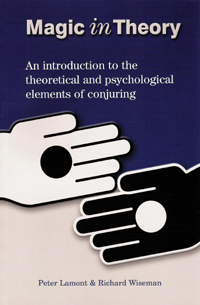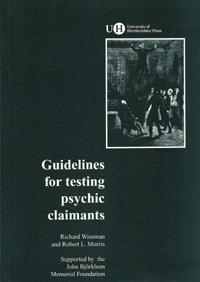

|
Pseudo-Psi |
The term 'pseudo-psi' refers to what's not psychic but looks like it. For instance, a person may judge that they have had a paranormal experience, when in fact there is a normal explanation for that experience. KPU research into the pseudo-psi hypothesis is summarised below. References can be found at the foot of this page and further information on parapsychology's terminology can be found on the Resources page.
 In many real-world, spontaneous psychic experiences, normal
psychological processes can lead a person mistakenly
to label their experience as paranormal. Take coincidences as an example.
Not only are we poor judges of probability, but also when there are numerous combinations of really large numbers of people
and events, apparently meaningful coincidences are bound to happen.
Furthermore, psychologists have shown that when an individual personally
experiences a coincidence, this coincidence is rated as more surprising
and meaningful than the same experience related by another person (Falk,
1989). Poor observation and inaccuracies in recollection may also
account for some pseudo-psychic experiences. For reviews, see Watt 1990-1991,
and Wiseman and Watt, 2006. Furthermore, some inexplicable phenomena are the product of exaggeration over time (Wiseman & Lamont, 1996).
In many real-world, spontaneous psychic experiences, normal
psychological processes can lead a person mistakenly
to label their experience as paranormal. Take coincidences as an example.
Not only are we poor judges of probability, but also when there are numerous combinations of really large numbers of people
and events, apparently meaningful coincidences are bound to happen.
Furthermore, psychologists have shown that when an individual personally
experiences a coincidence, this coincidence is rated as more surprising
and meaningful than the same experience related by another person (Falk,
1989). Poor observation and inaccuracies in recollection may also
account for some pseudo-psychic experiences. For reviews, see Watt 1990-1991,
and Wiseman and Watt, 2006. Furthermore, some inexplicable phenomena are the product of exaggeration over time (Wiseman & Lamont, 1996).
One major factor causing people to mistakenly label an experience as paranormal is deliberate deception. This has been an important line of research at the KPU. We have developed a theoretical approach to conjuring (Lamont &  Wiseman, 1999) and psychic fraud ( Wiseman & Morris, 1994), and have studied specific methods of pseudo-psychics (e.g., Roe, 1995). For example, in one KPU study participants were shown videotapes of a faked psychic demonstration of metal bending and were later asked to recall details of the demonstration. The results showed that compared to psi disbelievers, psi believers tended to remember fewer details relevant to how the trick was done (Wiseman & Morris, 1995a), suggesting a functional distortion of processing that serves to support pre-existing beliefs. We have also studied the broader techniques used by pseudo-psychics to frame what they do as real rather than trickery (Lamont, 2006).
Wiseman, 1999) and psychic fraud ( Wiseman & Morris, 1994), and have studied specific methods of pseudo-psychics (e.g., Roe, 1995). For example, in one KPU study participants were shown videotapes of a faked psychic demonstration of metal bending and were later asked to recall details of the demonstration. The results showed that compared to psi disbelievers, psi believers tended to remember fewer details relevant to how the trick was done (Wiseman & Morris, 1995a), suggesting a functional distortion of processing that serves to support pre-existing beliefs. We have also studied the broader techniques used by pseudo-psychics to frame what they do as real rather than trickery (Lamont, 2006).
Individuals claiming psychic abilities tend to be found in circumstances where the claimants have some control over how their apparent abilities are demonstrated and observed. These circumstances may be fruitful ones for the simulation of psychic abilities, therefore an important aspect of the KPU’s pseudo-psi research has been the development of methodological guidelines for testing psychic claimants (Wiseman & Morris, 1995b). Morris (1987) has also published recommendations for minimising participant fraud in parapsychology laboratories. It is hoped that the KPU’s pseudo-psi research will be beneficial not only to parapsychological studies, but also to cognitive and clinical psychology and other disciplines where deception may be involved.
Falk, R. (1989). Judgement of coincidences: Mine versus yours. American Journal of Psychology, 102, 477-493.
Lamont, P. (2006). Magician as conjuror: A frame analysis of Victorian mediums. Early Popular Visual Culture, 4, 131-142.
Lamont, P., & Wiseman, R. (1999). Magic in Theory. Hatfield: University of Hertfordshire Press.
Morris, R.L. (1987). Minimising subject fraud in parapsychology laboratories. European Journal of Parapsychology, 6, 137-149.
Roe, C. A. (1995). Pseudopsychics and the Barnum Effect. European Journal of Parapsychology, 11, 76-91.
Watt, C. (1990-1991). Psychology and coincidences. European Journal of Parapsychology, 8, 66-84. Download pdf (1870KB)
Wiseman, R. & Lamont, P. (1996). Unravelling the rope trick. Nature, 383, 212-213.
Wiseman, R., & Morris, R.L. (1994). Modelling the stratagems of psychic fraud. European Journal of Parapsychology, 10, 31-44.
Wiseman, R., & Morris, R.L. (1995a). Recalling Pseudo-Psychic Demonstrations. British Journal of Psychology, 86, 113-126.
Wiseman, R., & Morris, R. L. (1995b). Guidelines for Testing Psychic Claimants. Buffalo, NY: Prometheus.
Wiseman, R. & Watt, C. (2006). Belief in psychic ability and the misattribution hypothesis: A qualitative review. British Journal of Psychology, 97, 323-338. Download pdf (153KB)
Lamont, P. & Henderson, J. M. (2009). More attention and greater awareness in the scientific study of magic. Nature Reviews Neuroscience, advance online publication (correspondence), 29 January, doi:10.1038/nrn2473-c1.
Lamont, P., Henderson, J. M., & Smith, T. (in press). Where science and magic meet: the illusion of a 'science of magic'. Review of General Psychology.
Back to main Research page